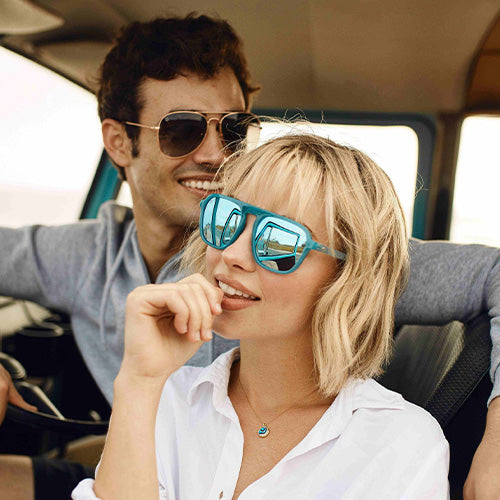BRANDING MAKES AFFORDABLE SUNGLASSES UNAFFORDABLE
So what are you paying for when you shell out big bucks for luxury brand sunglasses? Advertising and marketing. According to market research firm Statista Ltd., one luxury fashion group spent over 320 million dollars in marketing and advertising last year. But that’s a small expense compared to what a French luxury goods conglomerate spent last year: 10.5 billion dollars. Yes, that’s billion with a “B” in global advertising and promotion.
You can help fund these staggering ad budgets by paying more for your sunglasses. Or not if you choose to buy high-quality, lower-cost brands like Knockaround.
MARKUPS MAKE INEXPENSIVE SUNGLASSES EXPENSIVE
It’s a common rule of capitalism: retailers make money on extras. A lot of money. Add-ons and extra features offer the best opportunities to make the biggest markups. They allow retailers to raise the selling price and increase their profit margins. This is true for both sunglasses and prescription glasses. The LA Times puts it this way, “You’re paying a markup on glasses that would make a luxury car dealer blush, with retail costs from start to finish bearing no relation to reality.”
While the polarization markups for sunglasses vary, retailers commonly tack on an extra 30% for polarized lenses. That means the price tag can go up as much as $100 or even $200 with designer sunglasses. But Knockaround offers a range of styles with polarized and non-polarized lenses for the same or similar prices. That’s a 0% markup for polarized lenses!
GREAT POLARIZED SUNGLASSES DON’T COST A FORTUNE
The branding or luxury that’s associated with expensive sunglasses doesn’t correlate with performance. At all. Knockarounds, for example, prioritize lens technology and UV protection without compromising style. At affordable prices. A smart consumer would be wise to focus on the quality of the lenses and the level of protection sunglasses offer rather than allowing themselves to get swayed by brand names or high price tags. Cost doesn’t equal value.
Many people believe that sunglasses have to be expensive (which they perceive as higher quality) to protect their eyes from potential harm caused by the sun. That’s not true; the price tag of sunglasses does not determine their ability to shield your eyes from the sun’s damaging rays. For protection against high-energy blue light outdoors, for example, low-cost sunglasses outperform high-cost sunglasses. Researchers at the University of Texas found no connection between the price of sunglasses and protection from blue light.
SUNGLASSES FOR UV PROTECTION
What about UV light? Do you get big protection from UV rays even if you’re not paying high prices? Of course! Research also shows there is no correlation between the retail cost of glasses with polarized lenses and their effectiveness in blocking UV light. Findings published by Canada’s prestigious McGill University state it plainly: “You don’t get more UV protection the more money you spend.”
The McGill publication cites a study published in the Canadian Journal of Ophthalmology. That study tested 207 pairs of sunglasses—from cheap pairs to super expensive ones—to gauge their ability to filter out UV rays. The results? All sunglasses with price tags above $21 met the UV-protection standards set by the U.S. and the European Union. As did almost all the cheaper sunglasses they tested. Price played no factor in UV protection—despite what the eye-popping price tags of designer sunglasses may imply!
THE TRUE PRICE OF DESIGNER SUNGLASSES
Consumers aren’t always rational. More often than not, we buy things based on feelings rather than careful consideration of the relevant facts. The luxury goods market depends on this emotion-driven human behavior.
But there’s an unusual downside to buying luxury items: they can make you feel less confident. That sounds kinda backward, right? Shouldn’t sporting expensive shades, showing the world what you can afford, boost your confidence? No, not always. And you can easily expect to feel the reverse if you plunk down big money on sunglasses
A study by researchers at Boston College and Harvard Business School found that buying luxury items can have negative effects. They call this “The Impostor Syndrome.” Researchers discovered that people are often drawn to luxury goods when they feel less powerful and less confident than others; these confidence-seeking consumers believe that the luxury item will boost their self-esteem. It sounds logical—who wouldn’t feel better wearing something flashy and expensive? It turns out, lots of people.
When buying luxury items, the opposite of confidence-building is often the case. The Harvard study found that some people act with less confidence while wearing a luxury item. Why? They don’t feel true to themselves. Wearing a high-end watch or designer shades can make a person feel self-conscious and shy, and it can leave them feeling like they are out of their element. Researchers dub this unintended reaction the “psychological cost of luxury.” It can diminish any enjoyment and joy that a person might otherwise get from a purchase.
And this Impostor Syndrome exists among every kind of consumer. One might suspect that high-end consumers always feel at home with high-end items. But that’s not the case. The study found that the uncomfortable phenomenon exists in middle-class consumers and those who are in the luxury target market alike.
HIGH-PERFORMANCE SUNGLASSES AT A LOW COST
Do designer sunglasses have higher-quality lenses? Do these pricey shades use some kind of special material that’s not found in lower-cost sunglasses? No, and no.
Without naming brand names, there are lots of sunglasses in the $300 to $400 range that have polycarbonate lenses. Which is great. Made from shatter-resistant plastic, polycarbonate lenses are the “gold standard” for glasses of all kinds. It’s why Knockarounds have polycarbonate lenses. But you don’t need to pay hundreds of dollars to get sunglasses with these high-quality lenses.
Why are polycarbonate lenses so popular? Lightweight and resilient, polycarbonate lenses are up to ten times stronger than glass or regular plastic. This makes them the go-to material for people who lead active lifestyles. You’re not likely to find any lens material that is as impact-resistant as polycarbonate. Nor with a thinner design; polycarbonate lenses are about 30% thinner than standard plastic and glass lenses.
Versatility is also a big plus with polycarbonate. The material is particularly receptive to the application of special coatings, including UV, anti-glare, scratch-resistant, and blue-light-filtering coatings.
EVERYDAY SUNGLASSES FIT ACTIVE LIFESTYLES
Do you like getting active outdoors? Then your sunglasses should, too! That means you don’t want $250 sunglasses on your face when you’re out on the water kayaking, hiking through rough terrain, or playing volleyball on the beach. Lots of outdoor activities come with the risk of damaging your sunglasses. Can you ever truly relax if you’re worried about your sunglasses? And so you want a pair that can both stand up to the bumps and bruises of an active lifestyle and won’t cost a fortune should you need to replace them.
If you’re looking for sunglasses for running, you’ll want to check out Campeones. These novel wraparound shades were made for outdoor action, offering UV400 protection from the sun’s rays with an oleophobic and hydrophobic lens coating that repels water, oil, and sweat. With six different color options, lightweight Campeones let you take your unique sense of style on the go.
Is hiking more your thing? The perfect companion for all the trails you traverse, Premiums Sport sunglasses are constructed with super lightweight polycarbonate material, have UV 400 protection and have FDA-approved impact-resistant lenses. With refined arms and form-fitting frames, these unisex shades are sure to stay on your face no matter how rough the terrain gets.
If getting out on the greens is more your speed, we’ve got an amazing selection of sunglasses for golfing. Add some cool style to your swing with a pair of Torrey Pines Sport. Rubber nose pads keep your shades secure through the strongest of drives. With wide rectangular lenses, Torrey Pines capture the laid-back vibe of the stretch of California coast for which they’re named. Enjoy timeless style that’s at home on and off the golf course.
When you’re up for some downward dog, look to our collection of sunglasses for yoga. While they may be built for speed, Fast Lanes serve equally well for getting Zen and building strength in serenity. Perfect for people with medium and larger face shapes, Fast Lanes come in a range of vibrant colors to match the yoga mood you’re looking for.
From casual sunglasses to sophisticated shades, Knockaround has the best sunglasses for the money. While never sacrificing quality or style. So instead of spending a small fortune on your next pair of shades, why not get a high-quality pair (or two, or three) of Knockarounds?
Written for Knockaround by William McCleary










Do Sunglasses Block Blue Light?
What Do Blue Light Glasses Do?